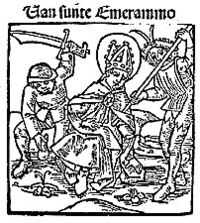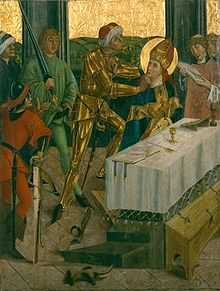Emmeram of Regensburg
| Emmeram of Regensburg | |
|---|---|
|
| |
| Bishop and Martyr | |
| Born |
unknown Poitiers, France |
| Died |
22 September 652 Helfendorf (Munich) |
| Venerated in |
Roman Catholic Church Eastern Orthodox Church |
| Canonized | 1833, Regensburg by Pope Gregory XVI |
| Major shrine | St. Emmeram's Abbey, Regensburg, Germany |
| Feast | 22 September |
| Attributes | carrying a ladder |
Saint Emmeram of Regensburg (also Emmeramus, Emmeran, Emeran, Heimrammi, Haimeran, or Heimeran) was born in Poitiers and was a Christian bishop and a martyr. He died circa 652 and is buried in St. Emmeram's in Regensburg, Germany. His feast day in the Catholic calendar of saints is 22 September.
Life
What we know of Emmeram comes to us second hand. Arbeo of Freising wrote a biography of Emmeram in 750, the Vita Sancti Emmerami, some 100 years after the saint's death. The literature tells the story of Emmeram, born into a noble family in Aquitaine. According to some, he became bishop of Poitiers,[1] though his name does not appear on the rolls. There is speculation that he held the office briefly between the death of Dido and the ascension of Ansoaldus. Having heard of idolatry in Bavaria, he decided to journey to Ratisborn (Regensburg) some time after the year 649 to the court of the Agilofing, Theodo I, Duke of Bavaria. He supposedly journeyed up the Loire, crossed through the Black Forest and then followed the Danube to Regensburg. Theodo welcomed Emmeram to his court, where Emmeram labored for three years carrying out missionary work. During this time he gained a reputation as a pious man.
As the story goes, Uta (or Ota), the daughter of the duke, confided to Emmeram that she was expecting a child out of wedlock. According to Arbeo, the father was one Sigipaldus from her father's own court. Moved with compassion, Emmeram advised her to name himself, whom every one respected, hoping to mitigate some of her shame.[1] Shortly thereafter, the legend goes, Emmeram abruptly went on a pilgrimage to Rome. At this point Uta named Emmeram as the father.
When Duke Theodo and his son Lantpert learned of Uta's pregnancy, Lantpert went after the bishop. Lantpert caught up to Emmeram in Helfendorf (now part of the Munich suburb of Aying) on the old Roman road between Salzburg and Augsburg on the Via Julia Augusta. Lantpert and his followers tied Emmeram to a ladder and proceeded to torture and cut Emmeram to pieces. The day of his martyrdom is also his name day, 22 September. His companions Vitalis and Wolflete found him still alive, lying in his own blood and tried to bring him quickly back to Aschheim, where at that time stood a walled church of the Apostle Peter.
Veneration
The prevalent legend of Emmeram's torture describes how he was bound to a ladder, and was hacked to pieces, starting with his finger tips. Later his eyes were put out and his nose was cut off. Still living, he asked for water. His companion Vitalis answered, "Why do you seek relief, when nothing of you remains but your stubby trunk, undecorated with limbs? I would think you should wish for your death rather than live with such shame." Emmeram answered that one should not attempt to hurry death, rather drag it out, in order to persuade the face of God's mercy through divine intervention. At this Emmeram was beheaded. As proof of Emmeram's innocence, a ladder was lowered to bear him to Heaven. As they carried his body to Aschheim, a wondrous light shone from his body.
A text printed in Munich in 1743, Officium oder Tageszeiten des wunderthätigen bayerischen Apostels und Blutzeugen Christi St. Emmerami, zu täglichen und andächtigen Gebrauch in allen Anliegen und Widerwärtigkeiten etc., states that the cart was accompanied by
| “ | Men and women of two hundred persons with great sympathy and prayer. A half hour before reaching Aschheim, the saint called for a halt, as within the hour his reward of heaven was before him. Then it happened that they lifted him down from the cart and laid him upon a beautiful sward, where he gave up his ghost at once... The place where this happened remained fresh and green for all time until finally through the alms of travelers (because all four roads come together there) and other good-hearted Christians had a church built, where even today many wonders still occur! | ” |
Arbeo of Freising depicted the place of his death as a
| “ | lovely, ever spring-green place, upon which a spring appeared and the local people later built a little church. | ” |
When the misunderstanding of Emmeram's relationship to Uta was revealed, Emmeram was entombed in Aschheim, whereupon legend states that it rained for forty days. Emmeram was exhumed and put upon a raft in the Isar. When the raft reached the Danube, it miraculously floated upstream to Regensburg, where Emmeram was interred in the church of St. George. His remains were moved by Bishop Gawibaldus to a church dedicated to the martyr. This church burned down in 1642. Emmeram's bones were found under the altar in 1645 and moved to St. Emmeram's Abbey. The church, now a basilica minor, houses his leg bones in a silver reliquary in the eastern portion under the altar. Bishop Ignaz de Senestrez canonically recognized the relics in 1833. They are displayed every year on 22 September.[1]
At the spot Saint Emmeram died in the year 652, a small chapel was erected in the year 1842. The chapel stands there today. The church of St. Lorenz in Oberföhring has a side altar dedicated to St. Emmeram. In the church of Saints Peter and Paul in Aschheim, a plaque memorializes the first grave of Emmeram with an inscription.
Notes
Sources
- (German) St. Emmeram from the Ökumenisches Heiligenlexikon
- (German) Emmeram von Regensburg article on the German language Wikipedia
External links
- Arnoldus Emmeramensis, De Miraculis Et Memoria Beati Emmerammi Libri Duo. by Migne Patrologia Latina
- http://www.santiebeati.it/dettaglio/91891

